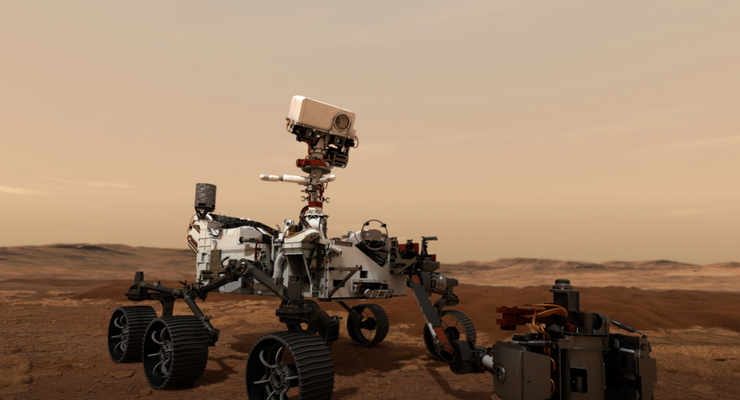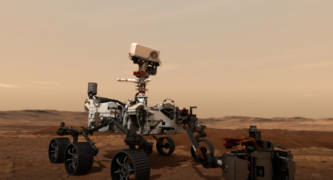
With just days until the scheduled launch of the Perseverance Mars Rover, Caltech recently discussed what to expect as the rover prepares to depart for Mars.
Mission Project Scientist Ken Farley, W. M. Keck Foundation Professor of Geochemistry and former chair of Caltech’s Division of Geological and Planetary Sciences (GPS); Deputy Project Scientist Katie Stack Morgan (MS ’11, PhD ’15) of JPL, which Caltech manages for NASA; and Chief Engineer Adam Steltzner (MS ’91) of JPL outlined the audacious mission, which will send a robotic rover to the Red Planet, where it will search for signs of past life while taking and caching samples that could one day be retrieved and returned to Earth. Meanwhile, the rover will also demonstrate several new pieces of technology, including the first helicopter to fly on a planet other than Earth and the JPL-built Mars Oxygen In-Situ Resource Utilization Laboratory, which will convert Mars’s thin atmosphere into oxygen.
“We are not looking for signs of extant life. There’s nowhere on the surface of Mars where we know a terrestrial organism could survive. But geological signs point to an extremely different past with lakes and rivers,” said Farley, and it is at the remains of these sites where Perseverance will look for evidence of ancient life.
To that end, the rover will land at Jezero Crater, on the western edge of a giant impact basin north of the Martian equator, the site of an ancient lake with a river delta deposit that represents an ideal place to look for signs of past life.
“Often you look at Mars as a landscape and it’s frozen in time … but there’s nothing like an ancient river deposit to remind you that all is not what it seems,” Stack Morgan said. The crater boasts some of the oldest rocks that scientists have ever spotted on Mars.
As a graduate student, Stack Morgan worked with Mars Science Laboratory (MSL) Curiosity rover Project Scientist John Grotzinger, Fletcher Jones Professor of Geology at Caltech and Ted and Ginger Jenkins Leadership Chair of GPS, an experience that she said helped prepare her for her new role in Perseverance. “I had the great fortune of being a senior graduate student with an advisor who encouraged me to follow my interests and passions, and so I found my way into parts of the mission that graduate students usually don’t find themselves,” she said. “I think a lot of the people that I work with now on [Mars] 2020 were younger engineers when we were all working together on MSL and so it’s been great to transition with them into this next mission. We all know each other now and appreciate our different perspectives.” Grotzinger and colleagues Bethany Ehlmann, professor of planetary science; and Woody Fischer, professor of geobiology; are co-investigators with Farley on the Perseverance Mars Rover.
Perseverance must launch in a few-week period this summer to avoid a two-year delay. Although the launch has been pushed back and is now scheduled for July 30, Steltzner said he is confident that the Atlas 541 rocket carrying the rover will be able to lift off during that time.
“Should we be scared? No. When the rocket’s ready and the thing on top of the rocket is ready, you have a 95 percent chance of a launch, provided there are no weather problems,” Steltzner said. “As long as we don’t have a hurricane kick up, we should have no problem going off on the 30th, or perhaps the next day or so. The odds of eating up the window are very, very low.”
Steltzner also highlighted the new technology that would hopefully make the “seven minutes of terror,” the period when the probe makes its final descent toward and landing onto Mars, a little less terrifying. Perseverance will use the same Entry, Descent, and Landing system as the Curiosity rover, but with added features to improve the accuracy of the landing. These features include a Terrain-Relative Navigation system that will allow the rover, as it descends with its parachute, to quickly compare what it sees on the surface below to a map of known hazards in the area, and to alter the course of its landing as needed.
The overall effect is that Perseverance should be able to land more safely, and at a location that is closer to interesting features, than was possible for Curiosity. That said, landing is the “single temporal concentration of risk for the mission. Don’t relax during landing,” Steltzner said.
Once Perseverance touches down, Steltzner will start looking ahead to future missions that are aimed at bringing samples cached by the rover during its mission (which should last at least one Mars year, or 687 Earth days) back to Earth. Meanwhile, Farley and Stack Morgan will focus on the task at hand: guiding a robot explorer across a harsh terrain in search of clues to the planet’s past, from millions of miles away.
“As division chair,” Farley joked, “I learned how to herd cats a little bit, [with] 35 faculty members, but this is an entirely different experience … [It will be] a big challenge for me, I think, and for Katie … keeping this 350-person science team focused on that long journey.”
The launch window for Perseverance begins on July 30 at 4:50 a.m. PDT.














 5 comments
5 comments


